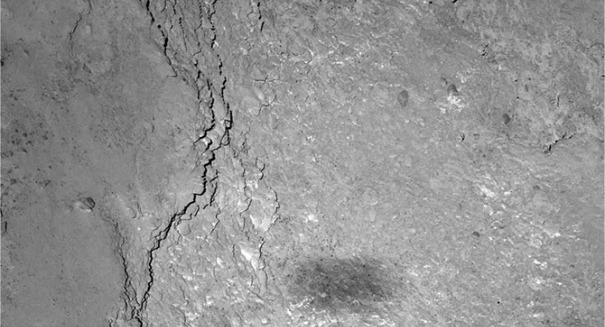
The surreal photo is more than just for kicks: it helps scientists gauge certain details about the surface by seeing how the shadow interacts with it.
It looks like there will be six more weeks of winter on Comet 67P: the Rosetta satellite has captured its own shadow in a recent high-resolution probe taken of the comet that was taken during a Valentine’s Day flyby.
Actually, it’s icy year-round on the comet, but it was still an interesting and surreal sight to see the shadow of the European Space Agency’s spacecraft when it hovered just 6 kilometers from the surface of the dirty comet, according to a BBC report.
The sun was directly behind Rosetta during the flyby, which allowed the spacecraft to snap photos of an area known as the “space duck.” Dr. Matt Taylor, the mission’s project scientists, said the picture provided a “nice juxtaposition of Rosetta against the alien landscape,” he said as quoted in the BBC.
The comet is getting very active as it approaches the sun, meaning that the probe can’t get too close to the celestial body, with gas and dust streaming off the comet and causing drag on the spacecraft. It’s tricky business for ESA controllers trying to keep Rosetta on track during its mission, as the Philae probe sits somewhere below on the comet trying to wake up from its slumber and resume collecting data.
As a result, Rosetta operators are keeping their distance from the comet and allowing for the occasional close approach, which is when the spacecraft swept over one of the lobes that create the comet’s unique shape.
Catching the shadow is more than just for curiosity’s sake: it also allows scientists to be able to track the progression of shadows during each flyby, which provides insight into the composition and behavior of the surface.
Rosetta’s instruments also allow it to sniff the inner parts of the atmosphere of the comet, also known as the coma, according to the report.
Rosetta is a long way off right now, about 328 million kilometers from our sun, but getting much closer at a speed of 83,000 kilometers per hour, or 23 kilometers per second, as the comet heads on an inward arc toward the sun. In mid-August, it will be at its closest distance: 186 million kilometers. At that point, the sun will melt the comet’s icy surface quickly, and Rosetta will need to back away to about a few hundred kilometers from the comet.
Leave a Reply